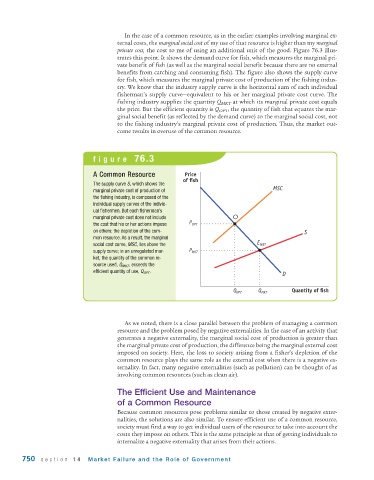Page 792 - Krugmans Economics for AP Text Book_Neat
P. 792
In the case of a common resource, as in the earlier examples involving marginal ex-
ternal costs, the marginal social cost of my use of that resource is higher than my marginal
private cost, the cost to me of using an additional unit of the good. Figure 76.3 illus-
trates this point. It shows the demand curve for fish, which measures the marginal pri-
vate benefit of fish (as well as the marginal social benefit because there are no external
benefits from catching and consuming fish). The figure also shows the supply curve
for fish, which measures the marginal private cost of production of the fishing indus-
try. We know that the industry supply curve is the horizontal sum of each individual
fisherman’s supply curve—equivalent to his or her marginal private cost curve. The
fishing industry supplies the quantity Q MKT at which its marginal private cost equals
the price. But the efficient quantity is Q OPT , the quantity of fish that equates the mar-
ginal social benefit (as reflected by the demand curve) to the marginal social cost, not
to the fishing industry’s marginal private cost of production. Thus, the market out-
come results in overuse of the common resource.
figure 76.3
A Common Resource Price
of fish
The supply curve S, which shows the
MSC
marginal private cost of production of
the fishing industry, is composed of the
individual supply curves of the individ-
ual fishermen. But each fisherman’s
marginal private cost does not include O
P
the cost that his or her actions impose OPT
on others: the depletion of the com- S
mon resource. As a result, the marginal
E
social cost curve, MSC, lies above the MKT
supply curve; in an unregulated mar- P MKT
ket, the quantity of the common re-
source used, Q MKT , exceeds the
efficient quantity of use, Q OPT .
D
Q OPT Q MKT Quantity of fish
As we noted, there is a close parallel between the problem of managing a common
resource and the problem posed by negative externalities. In the case of an activity that
generates a negative externality, the marginal social cost of production is greater than
the marginal private cost of production, the difference being the marginal external cost
imposed on society. Here, the loss to society arising from a fisher’s depletion of the
common resource plays the same role as the external cost when there is a negative ex-
ternality. In fact, many negative externalities (such as pollution) can be thought of as
involving common resources (such as clean air).
The Efficient Use and Maintenance
of a Common Resource
Because common resources pose problems similar to those created by negative exter-
nalities, the solutions are also similar. To ensure efficient use of a common resource,
society must find a way to get individual users of the resource to take into account the
costs they impose on others. This is the same principle as that of getting individuals to
internalize a negative externality that arises from their actions.
750 section 14 Market Failure and the Role of Gover nment

